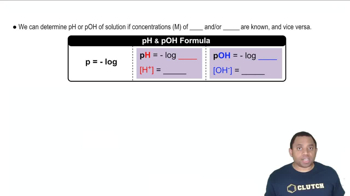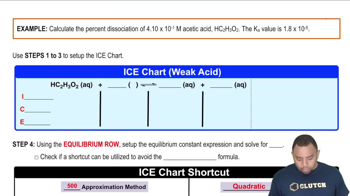Here are the essential concepts you must grasp in order to answer the question correctly.
pH and pOH
pH is a measure of the acidity or basicity of a solution, defined as the negative logarithm of the hydrogen ion concentration. A pH of 10.50 indicates a basic solution, where the concentration of hydroxide ions can be calculated using the formula pOH = 14 - pH. Understanding pH and pOH is essential for determining the concentration of hydroxide ions in the solution.
Recommended video:
Dissociation of CaO
Calcium oxide (CaO) is a strong base that dissociates completely in water to form calcium ions (Ca²⁺) and hydroxide ions (OH⁻). The reaction can be represented as CaO + H₂O → Ca²⁺ + 2OH⁻. Knowing the stoichiometry of this dissociation is crucial for calculating how much CaO is needed to achieve the desired hydroxide ion concentration for a specific pH.
Recommended video:
Percent Dissociation Example
Molarity and Mass Calculation
Molarity (M) is defined as the number of moles of solute per liter of solution. To find the mass of CaO required, one must first calculate the moles of hydroxide ions needed based on the desired pH, then use the molar mass of CaO to convert moles to grams. This process involves applying the formula: mass = moles × molar mass, which is fundamental in solution preparation.
Recommended video:
Molar Mass Calculation Example
 Verified step by step guidance
Verified step by step guidance


